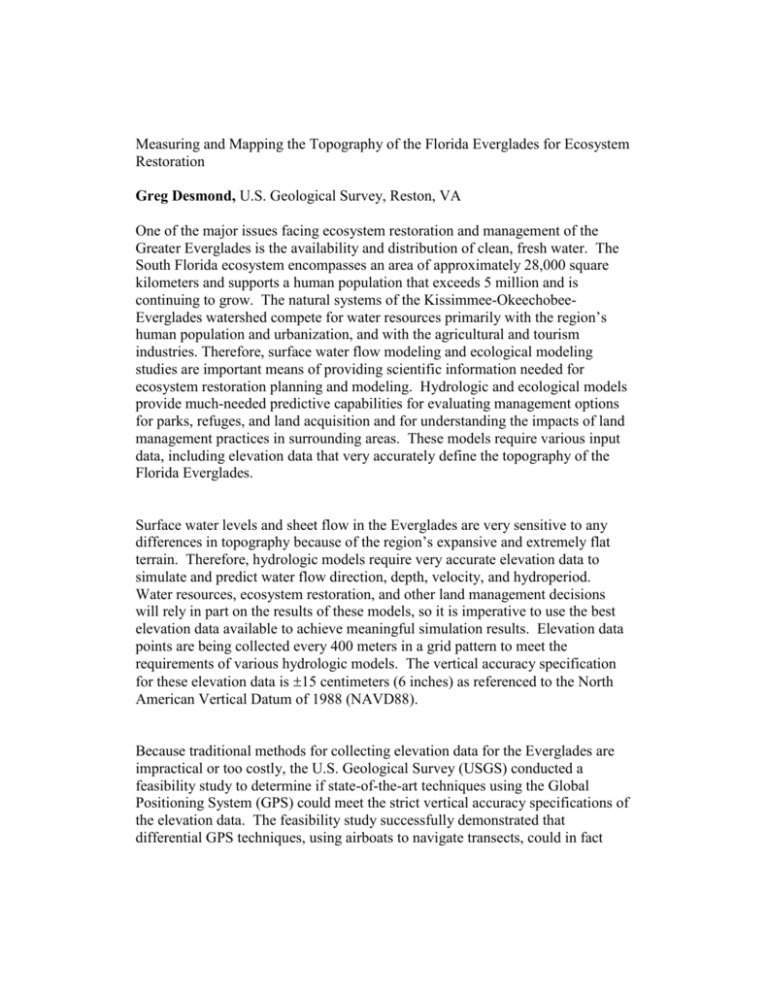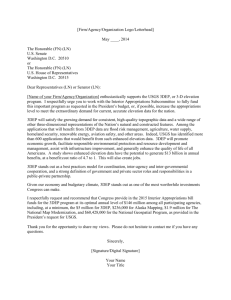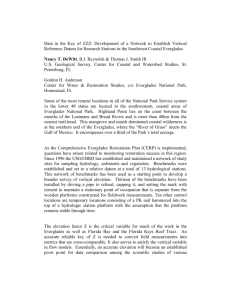South Florida Elevation Data Collection Using the Global
advertisement

Measuring and Mapping the Topography of the Florida Everglades for Ecosystem Restoration Greg Desmond, U.S. Geological Survey, Reston, VA One of the major issues facing ecosystem restoration and management of the Greater Everglades is the availability and distribution of clean, fresh water. The South Florida ecosystem encompasses an area of approximately 28,000 square kilometers and supports a human population that exceeds 5 million and is continuing to grow. The natural systems of the Kissimmee-OkeechobeeEverglades watershed compete for water resources primarily with the region’s human population and urbanization, and with the agricultural and tourism industries. Therefore, surface water flow modeling and ecological modeling studies are important means of providing scientific information needed for ecosystem restoration planning and modeling. Hydrologic and ecological models provide much-needed predictive capabilities for evaluating management options for parks, refuges, and land acquisition and for understanding the impacts of land management practices in surrounding areas. These models require various input data, including elevation data that very accurately define the topography of the Florida Everglades. Surface water levels and sheet flow in the Everglades are very sensitive to any differences in topography because of the region’s expansive and extremely flat terrain. Therefore, hydrologic models require very accurate elevation data to simulate and predict water flow direction, depth, velocity, and hydroperiod. Water resources, ecosystem restoration, and other land management decisions will rely in part on the results of these models, so it is imperative to use the best elevation data available to achieve meaningful simulation results. Elevation data points are being collected every 400 meters in a grid pattern to meet the requirements of various hydrologic models. The vertical accuracy specification for these elevation data is 15 centimeters (6 inches) as referenced to the North American Vertical Datum of 1988 (NAVD88). Because traditional methods for collecting elevation data for the Everglades are impractical or too costly, the U.S. Geological Survey (USGS) conducted a feasibility study to determine if state-of-the-art techniques using the Global Positioning System (GPS) could meet the strict vertical accuracy specifications of the elevation data. The feasibility study successfully demonstrated that differential GPS techniques, using airboats to navigate transects, could in fact meet the vertical accuracy requirement. Also, the land surface being surveyed in the Everglades is typically under water and obscured by vegetation. This precludes the use of other methods for collecting very accurate elevation data, such as photogrammetry, Light Detection And Ranging (lidar), Interferometric Synthetic Aperture Radar (ifsar), or other alternative remote sensing technologies. Therefore, topographic surveys over such a large area of the Everglades with such a stringent accuracy specification can only be accomplished efficiently by using GPS technology. This is especially the case in a harsh and inaccessible wilderness environment with unique landscape characteristics. Because the Everglades is so expansive and remote and includes environmentally sensitive areas, impenetrable vegetation, or other areas unapproachable by airboat, access to many places is possible only by helicopter. To solve this accessibility problem, the USGS developed a helicopter-based instrument, known as the Airborne Height Finder (AHF), which is able to measure the terrain surface elevation in a noninvasive, nondestructive manner. Using an airborne GPS platform and a high-tech version of the surveyor’s plumb bob, the AHF system distinguishes itself from remote sensing technologies in its ability to physically penetrate vegetation and murky water, providing reliable measurement of the underlying topographic surface. Accuracy tests have shown that the AHF system can consistently measure elevation points at the subdecimeter level. An accuracy test of the AHF was conducted in May 2000 when 17 National Geodetic Survey (NGS) first-order benchmarks were measured at two different helicopter hover heights. The average difference between the AHF measured elevations and the NGS published data sheet values was 3.3 cm. The largest difference was 8.6 cm, and the smallest difference was 0.2 cm. The root mean square error was 4.1 cm. These accuracy test results provide confidence that the elevation dataset being produced meets the 15 cm vertical accuracy specification. Elevation data collected with the AHF have been applied in the USGS-developed Southern Inland and Coastal System (SICS) numerical simulation model, which requires very accurate data for its hydrodynamic surface-water computations. The SICS model was originally constructed with topographic estimates based on preexisting contour maps. Although these contour maps meet national map accuracy standards, the derived elevation data are not adequate for hydrologic modeling purposes for the Florida Everglades. However, the distribution of surface-water flows simulated by the SICS model was greatly improved when the AHF elevation data replaced the previously estimated topography in the model. Flow and inundation estimates north of the West Lake area (southwest portion of the SICS model domain) are most significantly affected by this elevation difference. To date, tens of thousands of elevation data points covering significant parts of the Florida Everglades have been collected and processed using differential GPS methods with airboats and the helicopter-based AHF system. These data are organized by USGS 7.5-minute quadrangle maps and are available from the South Florida Information Access Web Site at http://sofia.usgs.gov. For more information, please contact: Gregory B. Desmond U.S. Geological Survey MS 521 National Center 12201 Sunrise Valley Drive Reston, VA, 20192 Phone: 703-648-4728 Fax: 703-648-4165 e-mail: gdesmond@usgs.gov.







